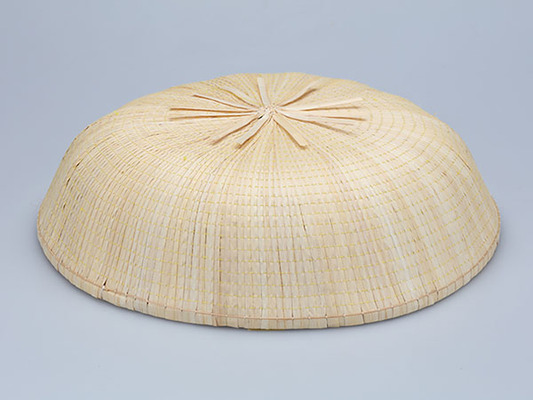
- Other crafts
- Toyama
Etchu Fukuoka Sedge Hats Etchu Fukuoka no suge gasa
Traditional techniques that have not changed for more than one hundred years
Hats produced from high quality sedges
Description
What is Etchu Fukuoka Sedge Hats ?
Etchu Fukuoka no suge gasa, Etchu Fukuoka Sedge Hats, are a traditional craft produced in Takaoka, Tonami, Oyabe, and Nanto of Toyama prefecture.
The sedges produced in Fukuoka, Toyama are top quality as they survive the severe winters of the Hokuriku region, and are delivered throughout Japan.
There are many types of sedge hats produced in Fukuoka, but a distinguishing characteristic is that they are all round hats.
The diameter of the hat can be adjusted in multiples of three centimeters. The frame of the hat is made in the size requested, and sedges are woven and sewn up.
Standard hats are tsuno gasa, a pointy hat used for farmwork, fuji gasa, shaped like Mt. Fuji, ohno gasa, shaped like a half sphere, dohbuka gasa, round on the edge to avoid the sunlight and rain, sando gasa, used by express messengers in the Edo period, jirocho gasa, the largest hat, tsumaori gasa, a traveling hat for women, and ichime gasa, which is said was used by the princesses in the Heian period. New types are helmet shaped hats, otome gasa, designed for women, fashionable, colorful hats called macaron, and a hexagonal hat called roppo.
Miniature hats are also popular for souvenirs. All of these hats are made using the traditional techniques that have been passed down for more than one hundred years. They have recently succeeded in dyeing sedges and are making new products with these dyed sedges.
History

Sedge hats have been produced in Fukuoka, Takaoka City in Toyama for a long time. It started when the Koyabe River repeatedly flooded until around the year 400, making a swamp on the banks where high quality sedges started to grow.
Straw raincoats were produced with these sedges. The light, good quality raincoats became popular, and the town started to make sedge hats as a side business. The production of hats was industrialized around 1670 with the protection and encouragement of Tsunanori MAEDA, the feudal lord of the Kaga Domain.
Production of sedge hats was at its peak at the end of the Edo period, producing a total of 2.1 million hats in 1864.
Demand for sedge hats for farmwork, dancing and folk crafts continued until the beginning of the 1960s, producing more than one million products per year, but currently the number has decreased to thirty thousand per year.
Even so, the advanced production skills are still used today, producing 90 percent of the total national production of sedge hats with their high quality local grown sedges.
General Production Process
 Photo:Etchu Fukuoka Sedge Hat Production Techniques' Preservation Society
Photo:Etchu Fukuoka Sedge Hat Production Techniques' Preservation Society
- 1. Drying the sedges
The sedges that have been planted and grown for approximately a year are harvested between late July to September and are dried in the sun.
Separating and drying:
The sedges are harvested on a sunny day and are separated. They are then dried in the sun for a whole day.
Fan drying:
The sedges are tied in bundles on the edge and are spread in the shape of a fan to be dried in the sun on sunny days for four to five days. The bundles are turned over to dry both sides, and the green sedges turn white as they become dry.
- 2. Making the frame (all year round)
The frame of the hat is made with bamboo. Japanese timber bamboo, Chinese temple bamboo, and moso bamboo is used. Flexible Japanese timber bamboo is used for the inner parts, while the strong Chinese temple bamboo and moso bamboo are used for the outer frame.
- 3. Sorting the sedges
The sedges are sorted to be used in different parts of the hat. The wide sedges called oya suge are used on the surface of the hat, the middle-sized sedges called shikake suge are used in the inner parts where they are woven like a spider's web, and the thin sedges called yoriko are used to tie the frames together.
- 4. Winding the shikake suge
A tool called sashibira, which is made by splitting a bamboo into the shape of a spatula, is used to split the shikake suge into two long strips. The split strips are wound around the frame one by one into the form of a spider web.
- 5. Attaching the wide sedges
The wide sedges are placed between the outer ring frame and the small ring frame on the top of the hat to form the surface, and are secured with thread.
- 6. Rubbing
The surface of the hat is rubbed with a rubbing spatula to polish and soften the sedges.
- 7. Sewing
Using a ten-centimeter-long needle and yellow thread, the hat is sewn from the outer ring towards the middle spirally. After the sewing is complete, the edges of the sedges are woven at the top of the hat.
See more Other crafts
- Edo kiriko cut glass
- Koshu lacquered deer leather
- Kyo folding fans
- Marugame uchiwa fans
- Boshu uchiwa fans
- Gifu lanterns
- Yamaga lanterns
- Kyo uchiwa fans
- Tendo Japanese chess pieces
- Edo glass
- Edo patterned paper
- Yame lanterns
- Owari Cloisonné
- Fukuyama Koto (Japanese Harp)
- Kyo art preservation
- Banshu fly-fishing flies
- Woodblock prints
- Koshu hand-carved seals
- Edo Hyogu (Art Mountings)
- Edo tortoise shell crafts
- Etchu Fukuoka Sedge Hats
- Gifu Japanese Umbrellas
- Nagasaki tortoise shell crafts
- Nagoya Sekku Kazari
- Sanshin
- Tokyo Koto (Japanese Harp)
- Tokyo Shamisen































































































































































































































































































